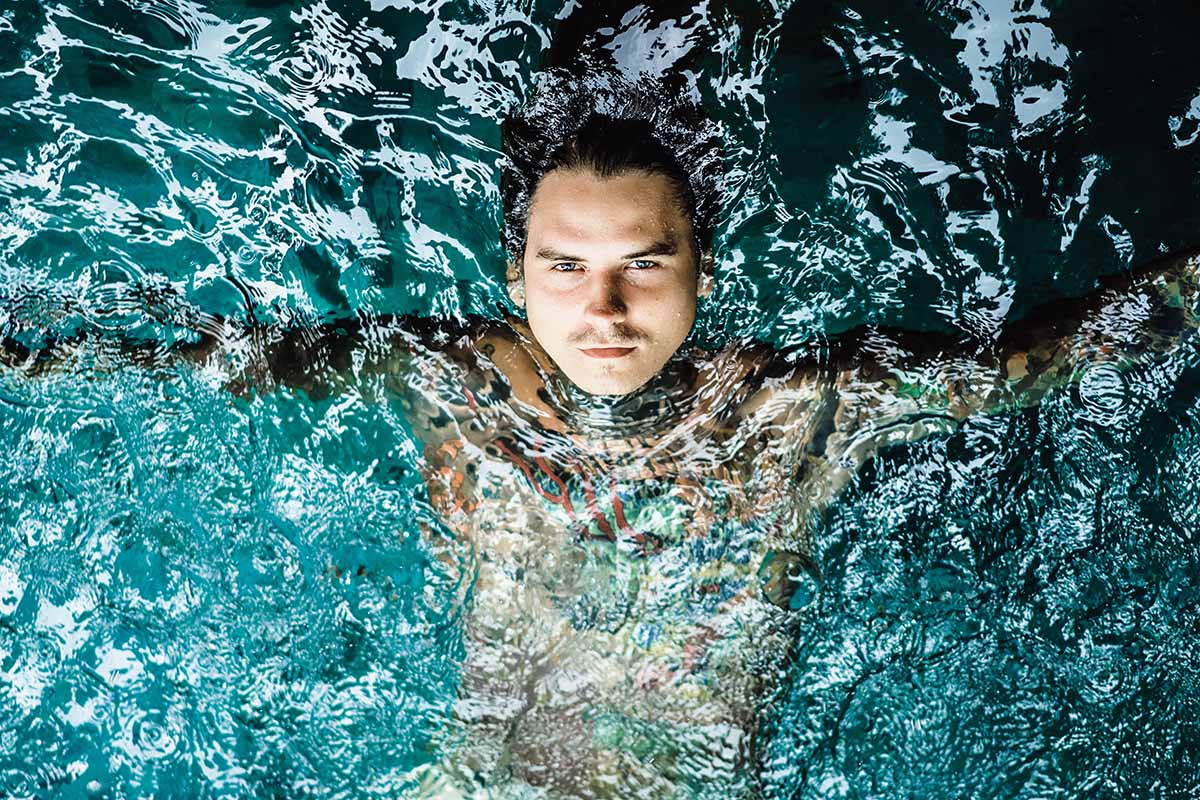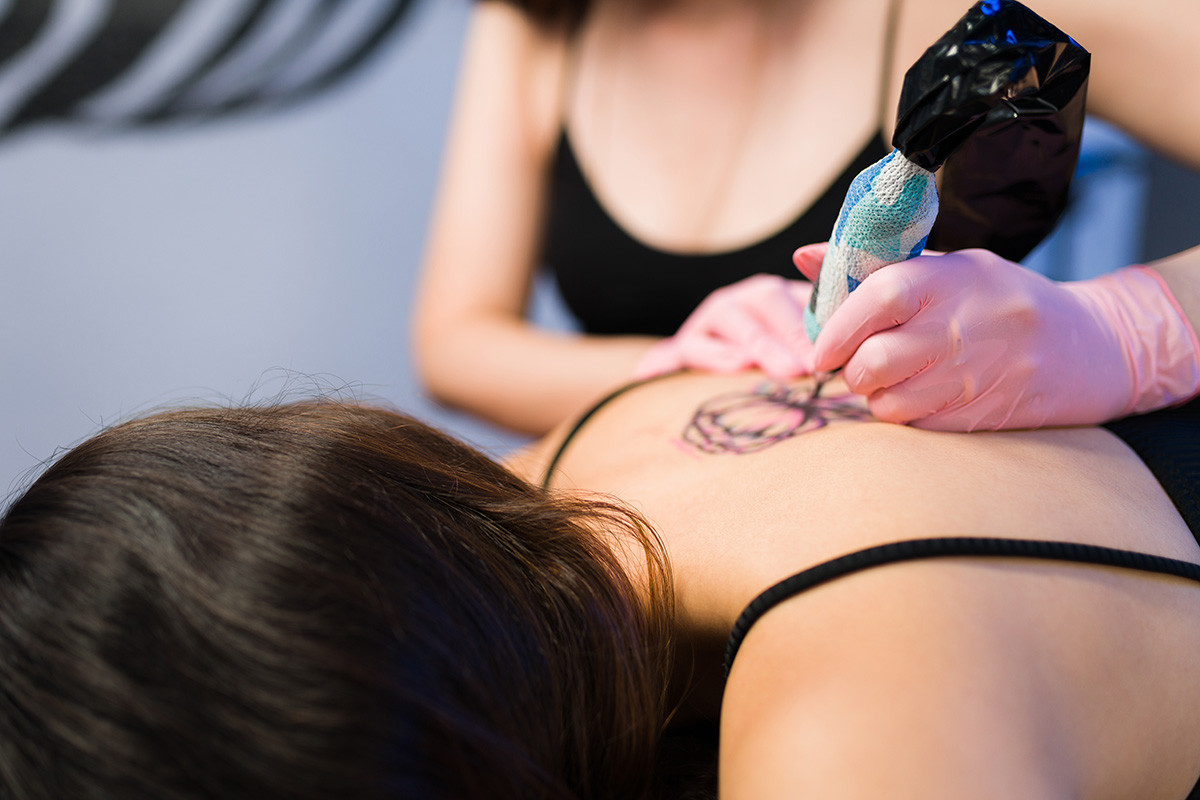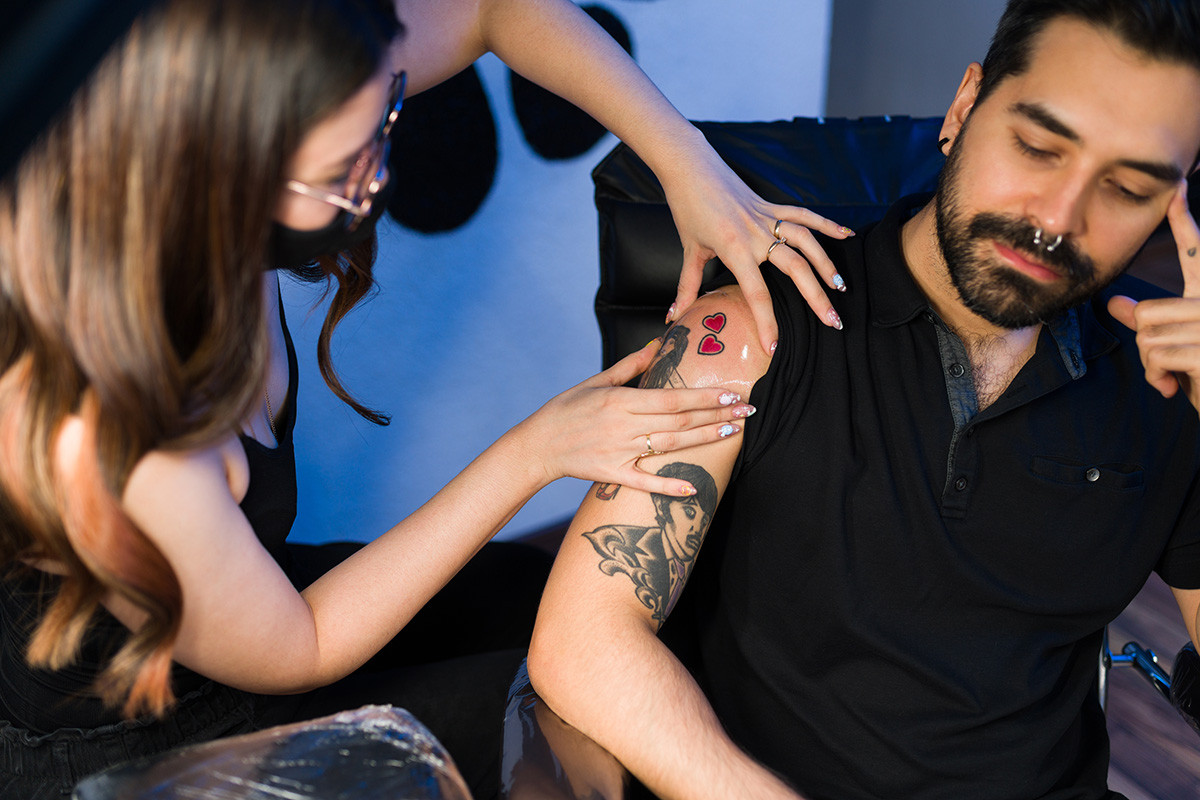How Many Days After A Tattoo Can You Swim? Ideally, wait at least 2-4 weeks before swimming to allow your new tattoo to heal properly, but understanding the tattoo healing stages is key to the best results. At tattooat.com, we emphasize proper tattoo aftercare to avoid bacterial infections and potential damage to your body art, ensuring your ink stays vibrant and your skin remains healthy. Dive into the world of tattoo care with confidence and explore a wealth of designs, connect with talented artists, and gain crucial knowledge about tattoo aftercare.
1. When Can You Dive In? Understanding Tattoo Healing
 A person getting a new tattoo and the healing process
A person getting a new tattoo and the healing process
Getting a new tattoo is a thrilling experience, but knowing when it’s safe to swim afterward is essential for the longevity and health of your tattoo. As a new tattoo is essentially an open wound, it is vulnerable to infection if exposed to water too soon. Tattoo artists generally recommend waiting 2 to 4 weeks before immersing your new tattoo in water such as swimming pools, hot tubs, or open water. The exact timeline can vary depending on several factors.
1.1 The Stages of Tattoo Healing
The tattoo healing process is a gradual progression involving several stages:
- Initial Stage: The first few days involve swelling, tenderness, and possibly some oozing.
- Itching Stage: As the tattoo begins to heal, itching is common. It’s important to resist the urge to scratch, as this can damage the tattoo and introduce bacteria.
- Peeling Stage: The outer layer of skin will start to peel, similar to a sunburn.
- Full Healing: Complete healing can take 2 to 4 weeks, but for some, especially with larger tattoos, it might take up to 6 months.
During this period, keeping the tattoo clean and dry is paramount. Submerging it in water, particularly public pools or natural bodies of water, poses a significant risk of infection.
1.2 Factors Affecting Tattoo Healing Time
Several factors can influence how quickly your tattoo heals:
- Tattoo Size: Larger tattoos typically require a longer healing period compared to smaller ones.
- Tattoo Location: Areas with more friction (e.g., joints) or moisture may take longer to heal.
- Individual Skin Type: Some skin types are more prone to irritation or slower healing.
- Aftercare Quality: Diligent aftercare, including regular cleaning and moisturizing, drastically reduces healing time. According to research from Portland State University’s Art Department, in July 2025, proper aftercare provides the best outcome.
- Overall Health: A healthy immune system aids in faster healing.
Closely monitoring your tattoo and consulting with your tattoo artist can help determine if your tattoo is healing correctly and when it might be safe to swim.
2. Risks of Swimming with A Fresh Tattoo
Swimming with a fresh tattoo can lead to several complications that can affect both the appearance and health of your skin. Water exposure can cause skin dryness, which results in itching, flaking, and scabbing. This, in turn, causes the tattoo to fade, become patchy, or develop blurred lines.
2.1 Bacterial Infections and Open Wounds
Tattoos are essentially open wounds, which makes them vulnerable to bacterial infections. Pools, oceans, and lakes contain various bacteria that can enter the body through the tattoo, causing infections, which can range from mild to severe, potentially requiring medical intervention. According to Inked Magazine, infections can delay the healing process and even damage your tattoo.
2.2 Chlorine and Salt Water Effects
Chlorine and salt water can negatively impact the healing of a new tattoo. Exposure to these elements can cause:
- Irritation: Both chlorine and salt can irritate the skin, leading to redness and discomfort.
- Fading: These chemicals can leach ink from your tattoo, causing it to fade prematurely.
- Discoloration: The colors of your tattoo may become distorted or less vibrant.
Even in chlorinated pools, not all bacteria are eliminated, meaning there’s still a risk of infection. Additionally, both chlorine and salt water can dry out the skin, exacerbating irritation and prolonging the healing process.
3. Protecting Your New Tattoo While Swimming: Precautions To Take
 A person protecting their new tattoo while swimming with waterproof dressings and bandages
A person protecting their new tattoo while swimming with waterproof dressings and bandages
If you absolutely must swim before your tattoo is fully healed, taking precautions is vital. It’s not ideal, but using waterproof dressings and bandages provides a barrier against water and bacteria. However, remember to remove the dressing immediately after swimming and thoroughly clean the tattoo to minimize the risk of infection.
3.1 Waterproof Dressings and Bandages
Waterproof dressings and bandages are essential for protecting a new tattoo if you need to swim. These products act as a barrier, keeping water and contaminants away from your fresh ink. Consider these options:
| Dressing Type | Key Features |
|---|---|
| Saniderm Tattoo Aftercare Bandage | Popular choice, breathable, and waterproof |
| Recovery Derm Shield Tattoo Aftercare | Flexible and provides a strong barrier against water |
| Nexcare Tattoo Bandages | Easy to apply and remove, suitable for smaller tattoos |
| Nuanchu Waterproof Bandage | Offers full coverage and protection against water |
| Tattoo Aftercare Waterproof Bandage | Specifically designed for tattoo aftercare, ensuring protection |
Apply the dressing before swimming and remove it promptly afterward. Change it regularly to maintain a clean and protected environment for your tattoo.
3.2 Post-Swim Care
Proper post-swim care is essential to minimize the risk of infection and damage. Follow these steps:
- Wash Gently: Use warm water and a mild, fragrance-free soap to cleanse the tattoo.
- Pat Dry: Use a clean towel to gently pat the area dry. Avoid rubbing, which can irritate the skin.
- Moisturize: Apply a thin layer of fragrance-free moisturizer to keep the skin hydrated and promote healing.
Consistent and careful aftercare helps ensure your tattoo heals properly and maintains its appearance.
4. Is Your Tattoo Healed? Signs Your Tattoo Is Ready For Swimming
Once your tattoo is fully healed, you can swim without worrying about damage or infection. Key indicators that your tattoo is ready include the absence of redness, itching, scabbing, or flaking. The skin should look smooth and even, without any peeling.
4.1 Visual Indicators
When assessing whether your tattoo is ready for swimming, check for these visual cues:
- No Redness or Peeling: The skin around the tattoo should not be red or actively peeling.
- Smooth Appearance: The tattoo should look smooth and even, with no raised areas.
- No Flaking or Scabbing: All scabs and flakes should have naturally fallen off.
Remember that healing varies from person to person, so continuous monitoring is crucial.
4.2 Consulting Your Tattoo Artist
Your tattoo artist is a valuable resource for determining when it’s safe to swim. With extensive experience in the healing process, they can assess your tattoo and offer expert guidance. If unsure, visit your tattoo artist for a professional check.
5. Alternative Water Activities During The Tattoo Healing Period
 A person enjoying alternative water activities during the tattoo healing period
A person enjoying alternative water activities during the tattoo healing period
If you’re eager to engage in water activities while your tattoo heals, several alternatives can help you stay clean without risking damage:
- Gentle Showers: Opt for quick, gentle showers instead of long baths. Avoid direct water jets on the tattoo.
- Boiled Water Cleansing: Use cooled, boiled tap water for cleaning the tattoo to reduce the risk of infection.
These alternatives help maintain cleanliness while minimizing the risk of waterborne complications.
6. Hot Tubs, Saunas, And Other Water Hazards
Hot tubs and saunas pose significant risks to new tattoos because of the warm, moist environments that can breed bacteria. It’s best to wait at least 3-4 weeks before exposing your tattoo to these environments. By avoiding these hazards, you protect your tattoo and ensure proper healing.
7. How Long After A Tattoo Can You Swim: Timeline Summary
Here’s a quick guide:
| Timeframe | Activity | Risks |
|---|---|---|
| First Week | Avoid all swimming | High risk of infection and damage |
| 2-4 Weeks | Consider swimming with waterproof protection | Moderate risk; ensure proper aftercare |
| After 4 Weeks | Generally safe to swim without protection | Low risk; monitor for any signs of irritation or infection |
Remember, patience is key to preserving the beauty and integrity of your new tattoo.
8. Showcasing Tattoo Excellence: Inspiration from Around the U.S.
The U.S. is home to a vibrant tattoo culture, with talented artists pushing the boundaries of creativity. Here are a few examples of tattoo styles and the artists known for them:
| Style | Artist (Location) | Description |
|---|---|---|
| Traditional | Sailor Jerry (deceased, Honolulu) | Bold outlines, classic Americana imagery |
| Realism | Nikko Hurtado (California) | Hyper-realistic portraits and images |
| Watercolor | Sasha Unisex (Russia, travels globally) | Soft, vibrant, and flowing designs that mimic watercolor paintings |
| Blackwork | Roxx (New York) | Bold, graphic designs using only black ink |
| Neo-Traditional | Megan Massacre (New York) | Modern twist on traditional designs with vibrant colors and detailed linework |
These artists represent a fraction of the talent available in the U.S. Explore tattooat.com to find more artists and inspiration for your next tattoo.
9. Staying Updated: Tattoo Conventions and Events in the U.S.
Staying connected with the tattoo community means attending conventions and events where you can meet artists, see the latest trends, and get tattooed. Here are a few major events:
| Event | Location | Month | Description |
|---|---|---|---|
| Philadelphia Tattoo Arts Convention | Philadelphia, PA | February | One of the largest and most respected tattoo conventions in the U.S., featuring hundreds of artists and vendors. |
| Hell City Tattoo Festival | Columbus, OH | May | Known for its dark and alternative atmosphere, showcasing a wide range of tattoo styles. |
| Tattoo Music & Arts Festival | Denver, CO | April | Combines tattoo artistry with live music and other art forms, creating a unique and vibrant experience. |
| Golden State Tattoo Expo | Pasadena, CA | January | Features some of the best tattoo artists in the world, offering a wide range of styles and techniques. |
| Motor City Tattoo Expo | Detroit, MI | August | A major event in the Midwest, attracting artists and enthusiasts from across the region. |
Attending these events provides an excellent opportunity to immerse yourself in the tattoo world and discover new inspirations.
10. Let tattooat.com Be Your Guide: Find Inspiration and Expert Advice
Ready to take the next step in your tattoo journey? At tattooat.com, you’ll discover a vast gallery of designs, find talented artists, and access expert advice on everything from aftercare to the latest trends. Whether you’re planning your first tattoo or adding to your collection, we’re here to help you make informed choices and achieve stunning results. Explore tattooat.com today and bring your tattoo vision to life.
Address: 1825 SW Broadway, Portland, OR 97201, United States
Phone: +1 (503) 725-3000
Website: tattooat.com
11. Frequently Asked Questions
11.1 What Happens If You Swim While Your Tattoo Is Healing?
Swimming with a healing tattoo can be dangerous because the water might contain bacteria that cause infections. It can also irritate the skin, leading to itching and potential damage to the tattoo.
11.2 Can I Swim 7 Days After A Tattoo?
No, it’s best to wait at least two to four weeks before swimming to allow the tattoo to heal and avoid the risk of infection.
11.3 How Long After A Tattoo Can You Swim In Chlorine?
Wait at least two weeks, but ideally four to six weeks, before swimming in chlorinated water to minimize the risk of irritation and infection.
11.4 Can I Use Waterproof Dressings To Protect My Tattoo While Swimming?
Yes, waterproof dressings can provide a protective barrier, but it’s still best to avoid swimming until the tattoo is fully healed.
11.5 What Are The Risks Of Swimming With A Fresh Tattoo?
The risks include bacterial infections, skin irritation, and potential damage to the tattoo design, emphasizing the need to wait until the tattoo is fully healed.
11.6 How Long Should I Wait To Take A Bath After Getting A Tattoo?
It’s generally recommended to avoid taking baths for at least two weeks after getting a tattoo to prevent prolonged water exposure.
11.7 Can I Go In A Hot Tub After Getting A Tattoo?
No, hot tubs should be avoided for at least 3-4 weeks after getting a tattoo due to the high risk of bacterial infections in the warm water.
11.8 How Can I Clean My Tattoo After Being Exposed To Pool Water?
If you accidentally expose your new tattoo to pool water, wash it immediately with mild, fragrance-free soap and warm water. Pat it dry with a clean towel and apply a thin layer of moisturizer.
11.9 Is It Safe To Use Saniderm While Swimming?
Saniderm is waterproof and can protect your tattoo while swimming, but it’s important to follow the manufacturer’s instructions and change the bandage as directed.
11.10 What Are The Best Ways To Ensure My Tattoo Heals Properly?
To ensure your tattoo heals properly, follow these guidelines: keep the tattoo clean and dry, avoid excessive sun exposure, wear loose clothing, and apply a fragrance-free moisturizer regularly.
